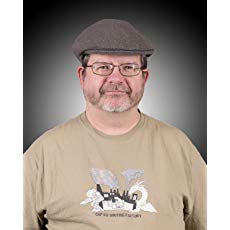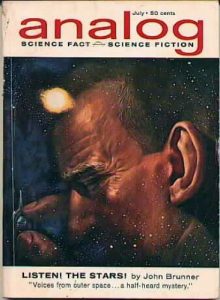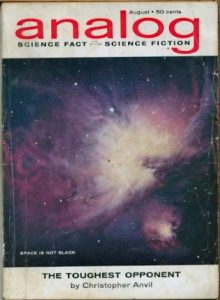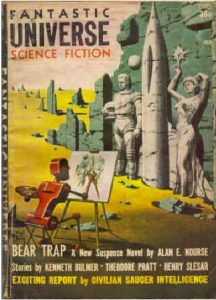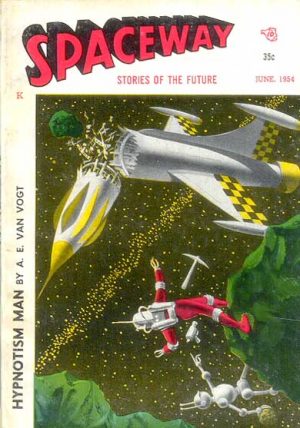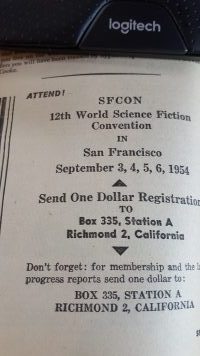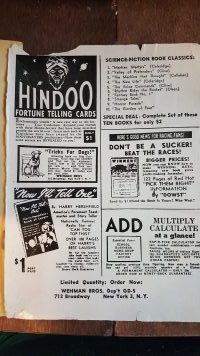This week I’ve been pleased to receive a whole slew of short stories for the FantaSci anthology. All told, we received 37 entrants, which seems like a good number to me. Chris and I are still discussing the ones we’re going to choose, so I’m not going to talk about results just yet.
However, since it’s fresh on my mind, I thought I’d go over some of the things I saw in this process. At this point, I’ve read a bunch of short stories over the years, written a dozen or so, and am in the process of editing my second anthology. There are many out there with more experience than I, but this contest really helped coalesce my thoughts on short stories to something more concrete, so I’m going to post on this as much for me to remember as to help you all.
Let me lay down one overarching principle: “Only *this* story matters.” There’s your TL:DR of this post. Only this story matters and anything that’s extraneous drags it down.
First, let’s talk about exposition. The vast majority of stories that got put straight to the bottom of our list explained too much. There’s little that’ll bring a story to a screeching halt like a sizable infodump near the start.
Yes, readers need to know stuff. They’ll get frustrated when something isn’t explained. However, you want to only explain what you have to explain for *this* story, even if you have plans for that story being a part of a larger setting.
If you plan to compile a collection of connected short stories into a novel, you can come back and add exposition later if needed. But that’s part of that process, not this story.
Readers don’t always need to know technical details or the physics/metaphysics underlying a universe. They need to know only if the plot twist turns on it. Most of Asimov’s robot stories turn on the Three Laws, so the reader has to know them. But details how robots work? Not as much.
It’s really easy to throw in details the author thinks the reader needs to know. It’s rare, especially without more experience, for an author to limit that exposition to actually what is needed for *this* story. Believe me, I’m as guilty of this as anyone, and it’s a major part of my editing process to cut that sort of thing out of my own stuff.
For Songs of Valor, authors had 7-10,000 words to strike with. And I mean strike! Short stories work best with action, in my mind, not explanations of this and that. That especially includes a bunch of stuff about what the character is thinking. Show, don’t tell, the character as much as possible.
Now I don’t mind a character parsing through tactical choices a bit. “I did this to learn this and then did that to get this reaction.” This is, I think, especially useful in first person noir style stuff.
But even that’s a balance. For None Call Me Mother, a novel which needed more tactical discussion than a short story, my editor told me I’d gone overboard and I cut back on them dramatically to get a faster, sharper story. Editors are nice like that and the 148k original draft that seemed bloated ended up as a 124k sleek creature I’m pretty pleased with.
Tell us what we need to know and nothing else. And whenever possible, weave it into conversations and side notes in the story and avoid a major infodump.
But that brings up an obvious question, how do you know what the reader needs to know?
For me, short stories have a soul. This is true of all stories, long or short, but I think it’s more important with shorter stories because you have to focus on that soul and nothing else. With novels, you want to have some misdirection, extra plants, and some additional frippery. There’s simply not enough time for much of that in shorts.
The problem is that “soul” is such an amorphous term. I’m a pantser, especially with short stories. It is extremely rare that I know the soul of the story when I start it. It’s happened once, with my story “Far Better to Dare” from Those in Peril, but that’s it.
Most of the time I write at least 4-6,000 words before I realize what the soul of the story really is. Then I realize that much, if not most, of what I’ve written so far is not actually relevant to the soul of *this* story. Maybe I had to write it out to know the character well enough, or the events underlying the story, or whatever, but all that stuff is just background and I have to cut some, if not nearly all, of what I’ve written.
This is hard. You have to be ruthless with your own writing and take extra stuff out. Don’t delete it, of course, you may use it later elsewhere, but not here.
Of the stories we received that I thought had potential but weren’t in our top 4 and thus a part of the anthology, I would say nearly all of them suffered from too much exposition that didn’t matter to that story’s soul. In some cases, this exposition was the kernel of the story, and hence the author thought it had to be in the story. However, that’s not always the case, and took away space for action without adding as much as the author realized. That chunk mattered, because it drove the character, but the reader didn’t need to see all of it, just hints of it.
Let me give you an example from my story from this anthology. Its POV character is Katarina, the chaotic evil crime boss from Achrida who Edward has to deal with far too often. I initially started with a thread of her comparing people around her to those she’s murdered in the past. Number twelve, number two, number 47, etc. It’s a fun thread for this character and I had to have it in mind as I was writing from Katarina’s point of view as the most unlikely/reluctant hero I could think of, but those words were wasted in this story.
Don’t worry, I have all those murders saved and listed.
But what’s the soul of the story? That’s hard to determine and it could be really far afield from where you started.
When I started writing “Here Must We Hold,” my story about the Battle of Maldon in Trouble in the Wind, I wanted to write a version where Byrhtnoth’s decisions weren’t because of “ofermod,” or hubris, but rather from smart strategic thinking that gave up a tactical advantage. That’s there, of course, but in the end, it became about something else, a pure redemption arc I won’t spoil by describing here. That forced me to change the entire structure of the story, remove some particulars, and add others.
My story in We Dare, “The Chaos of Well-Seeming Forms,” is a version of the Finnsburh Episode & Fragment, or Romeo & Juliet if you prefer, set on Mars. That was all, but in the end, it became more of a story about the hero in the Wanderer or the Seafarer, two of my favorite Old English poems. That, too, forced a series of changes, cuts, and tweaks. I didn’t realize that until I reached the absolute end of the story and needed the extra gut punch.
I could describe the journey of each story I’ve written, but I think you get the point. Be open to finding a soul of the story after you’ve written it, then shaping the story around it.
Whatever I’m writing, I constantly think about Raghunath Rao. He’s a character from the Belisarius series by Eric Flint and David Drake. He is fond of saying, “Only the soul matters in the end.” Not a bad thing to remember when writing short stories.
Returning to “The Chaos of Well-Seeming Forms,” I mentioned I thought it needed an extra gut punch and that’s because I think short stories need a twist. Something at the end that forces the reader to think and want more. I get this philosophy from one writer in particular, my favorite writer of short stories ever, Randall Garrett.
He was about as flawed a man as he could be, which is why many of you have never heard of him. He wrote only when he needed drinking money. However, he was so good he could go to John Campbell and ask for an advance on a story and get it! What a crazy thing, especially in the era of the pulp magazines of the 50s and 60s.
If you ever see a copy of The Best of Randall Garrett paperback in a used book store, get it. Even if you already have a copy so you can gift it to someone. There’s an e-book on Amazon with the same title, but it’s not the same as the paperback, though the two are linked. Here’s the link for the paperback on Amazon: https://www.amazon.com/Best-Randall-Garrett-1982-01-01/dp/B01K3JZWX2. Again, the e-book version is not the same.
That paperback has the single best collection of SF/F short stories I’ve ever found. Every story in here is absolutely amazing and powerful. And they all have a twist at the end, some which have never stopped resonating with me since the first time I read this collection in the early 80s. I would never suggest anyone emulate Garrett’s life, but his skills as a writer of short stories are hard to match.
So I try to have all my stories have some sort of twist at the end. It could be just a subtle thing like the last word in “Far Better to Dare.” It could be big like the gut punch at the end of “The Chaos of Well-Seeming Forms.” The twist in “What’s in a Name” is the word “Deor,” which is an odd word in Old English, but which added a neat addition to the redemption of Edward, provided the title, and shaped the soul slightly.
Doesn’t really matter what the twist is, nor is it necessarily a requirement. However, I think we can all understand that a story that hits you at the end with something extra is likely to be more memorable than without. In an anthology where you’re surrounded by great stories, it’s easy to get lost in the shuffle. And if you’re in a muddle of 37 stories for a competition, it’s even more important.
Finally, I’m going to touch on something that’s important, but which *can* be overcome, and that’s the use of language.
This is a fantasy anthology. We got a variety of definitions of fantasy, which was great, but of course some of it was medieval fantasy. There were a few of these submissions that suffered because the language was too modern for the setting. Imagine, if you will, Gandalf saying, “Well, hindsight is 20/20.” Wait. What? That totally throws me out of the story. So does “OK.”
Likewise, if you’re writing an urban fantasy or SF and the characters speak in a Shakespearean style, the readers are going to wonder what the heck is going on. It might work, like David Weber’s Jiltanith character from his Mutineer’s Moon series, but it has to be explained.
It may seem cool, but that exposition might take the place of action later on or confusing the soul of the story. In other words, getting in the way of the story’s power.
Now, sure, an editor can go through and edit all of the modernisms out of a medieval fantasy story, or whatever other oddnesses might be there, but in a contest, it’s a factor from the editor’s point of view. It means your story has to be clearly one of the winners. In a tie or close race between two stories, it will matter more. It’s quite literally part of the discussion Chris and I are having right now.
So to sum up, here you go.
- Only *this* story matters right now.
- Exposition only as needed for *this* story.
- Only the soul of *this* story really matters, in the end.
- Find a twist to give *this* story extra punch if you can.
- Use only the language that makes *this* story work.
Yeah, sure, these targets are amorphous and difficult to hit. I’m also not perfect at hitting them. However, I know that when I have these principles in mind, I write better stories. I also know that those stories submitted for this anthology that matched these principles got noticed more.
Again, you’ll find others out there with more experience than me, and also more success. You should absolutely pay attention to them. Also, there’s one true way of writing, and it’s whatever works for *you.* Still, I would say you wouldn’t go wrong at least considering these five things as you write short stories.

